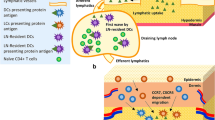Abstract
The administration of therapeutic proteins via the subcutaneous route (sc) is desired for compliance and convenience, but could be challenging due to perceived immunogenic potential or unwanted immune responses. There are clinical and preclinical data supporting as well as refuting the generalized notion that sc is more immunogenic. We provide a mechanistic perspective of immunogenicity of therapeutic proteins administered via the sc route and discuss strategies and opportunities for novel therapeutic approaches to mitigate immunogenicity.

Similar content being viewed by others
REFERENCES
Tang L, Persky AM, Hochhaus G, Meibohm B. Pharmacokinetic aspects of biotechnology products. J Pharm Sci. 2004;93:2184–204.
Tiede A et al. Safety and pharmacokinetics of subcutaneously administered recombinant activated factor VII (rFVIIa). J Thromb Haemostasis: JTH. 2011;9:1191–9.
Braun A, Kwee L, Labow MA, Alsenz J. Protein aggregates seem to play a key role among the parameters influencing the antigenicity of interferon alpha (IFN-alpha) in normal and transgenic mice. Pharm Res. 1997;14:1472–8.
Genovese MC et al. Subcutaneous abatacept versus intravenous abatacept: a phase IIIb noninferiority study in patients with an inadequate response to methotrexate. Arthritis Rheum. 2011;63:2854–64.
Schiff M. Subcutaneous abatacept for the treatment of rheumatoid arthritis. Rheumatology (Oxford). 2013;52:986–97.
Bartelds GM et al. Development of antidrug antibodies against adalimumab and association with disease activity and treatment failure during long-term follow-up. JAMA. 2011;305:1460–8.
Peng A, Kosloski MP, Nakamura G, Ding H, Balu-Iyer SV. PEGylation of a factor VIII-phosphatidylinositol complex: pharmacokinetics and immunogenicity in hemophilia A mice. AAPS J. 2012;14:35–42.
FDA. Drug approval package. Adalimumab. 2002. http://www.accessdata.fda.gov/drugsatfda_docs/nda/2008/125057s110TOC.cfm. Accessed March 2013.
Torosantucci R et al. Identification of oxidation sites and covalent cross-links in metal catalyzed oxidized interferon beta-1a: potential implications for protein aggregation and immunogenicity. Mol Pharmaceutics. 2013;10:2311–22.
Mianowska B et al. Immunogenicity of different brands of human insulin and rapid-acting insulin analogs in insulin-naive children with type 1 diabetes. Pediatr Diabetes. 2011;12:78–84.
Eckardt KU, Casadevall N. Pure red-cell aplasia due to anti-erythropoietin antibodies. Nephrol Dial Transplant. 2003;18:865–9.
Peng A et al. Effect of route of administration of human recombinant factor VIII on its immunogenicity in hemophilia A mice. J Pharm Sci. 2009;98:4480–4.
Schellekens H. Immunogenicity of therapeutic proteins. Nephrol Dial Transplant: Off Publ Eur Dial Transpl Assoc - Eur Renal Assoc. 2003;18:1257–9.
Schellekens H. The immunogenicity of therapeutic proteins. Discov Med. 2010;9:560–4.
Shortman K, Liu YJ. Mouse and human dendritic cell subtypes. Nat Rev Immunol. 2002;2:151–61.
Bogunovic M et al. Identification of a radio-resistant and cycling dermal dendritic cell population in mice and men. J Exp Med. 2006;203:2627–38.
Reis e Sousa C, Germain RN. Analysis of adjuvant function by direct visualization of antigen presentation in vivo: endotoxin promotes accumulation of antigen-bearing dendritic cells in the T cell areas of lymphoid tissue. J Immunol. 1999;162:6552–61.
Manickasingham S, Reis e Sousa C. Microbial and T cell-derived stimuli regulate antigen presentation by dendritic cells in vivo. J Immunol. 2000;165:5027–34.
Zhong G, Reis e Sousa C, Germain RN. Antigen-unspecific B cells and lymphoid dendritic cells both show extensive surface expression of processed antigen-major histocompatibility complex class II complexes after soluble protein exposure in vivo or in vitro. J Exp Med. 1997;186:673–82.
Banchereau J, Steinman RM. Dendritic cells and the control of immunity. Nature. 1998;392:245–52.
Geijtenbeek TB, van Vliet SJ, Engering A, t Hart BA, van Kooyk Y. Self- and nonself-recognition by C-type lectins on dendritic cells. Annu Rev Immunol. 2004;22:33–54.
Nagao K et al. Murine epidermal Langerhans cells and langerin-expressing dermal dendritic cells are unrelated and exhibit distinct functions. Proc Natl Acad Sci U S A. 2009;106:3312–7.
Hwang ST. Homeward bound: how do skin dendritic cells find their way into the lymph system? J Investig Dermatol. 2012;132:1070–3.
Iezzi G et al. Lymph node resident rather than skin-derived dendritic cells initiate specific T cell responses after Leishmania major infection. J Immunol. 2006;177:1250–6.
Ruedl C, Koebel P, Bachmann M, Hess M, Karjalainen K. Anatomical origin of dendritic cells determines their life span in peripheral lymph nodes. J Immunol. 2000;165:4910–6.
Itano AA et al. Distinct dendritic cell populations sequentially present antigen to CD4 T cells and stimulate different aspects of cell-mediated immunity. Immunity. 2003;19:47–57.
Porter CJ, Charman SA. Lymphatic transport of proteins after subcutaneous administration. J Pharm Sci. 2000;89:297–310.
Kabashima K et al. CXCL12-CXCR4 engagement is required for migration of cutaneous dendritic cells. Am J Pathol. 2007;171:1249–57.
Allan RS et al. Migratory dendritic cells transfer antigen to a lymph node-resident dendritic cell population for efficient CTL priming. Immunity. 2006;25:153–62.
Pisal DS, Kosloski MP, Middaugh CR, Bankert RB, Balu-Iyer SV. Native-like aggregates of factor VIII are immunogenic in von Willebrand factor deficient and hemophilia a mice. J Pharm Sci. 2012;101:2055–65.
Idoyaga J et al. Specialized role of migratory dendritic cells in peripheral tolerance induction. J Clin Investig. 2013;123:844–54.
Horwitz DA, Zheng SG, Gray JD. Natural and TGF-beta-induced Foxp3(+)CD4(+) CD25(+) regulatory T cells are not mirror images of each other. Trends Immunol. 2008;29:429–35.
Purohit VS, Ramani K, Sarkar R, Kazazian Jr HH, Balasubramanian SV. Lower inhibitor development in hemophilia A mice following administration of recombinant factor VIII-O-phospho-L-serine complex. J Biol Chem. 2005;280:17593–600.
Ramani K et al. Phosphatidylserine containing liposomes reduce immunogenicity of recombinant human factor VIII (rFVIII) in a murine model of hemophilia A. J Pharm Sci. 2008;97:1386–98.
Gaitonde P, Peng A, Straubinger RM, Bankert RB, Balu-Iyer SV. Phosphatidylserine reduces immune response against human recombinant factor VIII in hemophilia A mice by regulation of dendritic cell function. Clin Immunol. 2011;138:135–45.
Gaitonde P et al. Exposure to factor VIII protein in the presence of phosphatidylserine induces hypo-responsiveness toward factor VIII challenge in hemophilia A mice. J Biol Chem. 2013;288:17051–6.
ACKNOWLEDGMENTS
The authors are grateful for the financial support from National Heart, Lung and Blood Institute, National Institute of Health, HL-70227, to svb.
Conflict of Interest
The authors declare that there is no financial conflict of interest.
Author information
Authors and Affiliations
Corresponding author
Rights and permissions
About this article
Cite this article
Fathallah, A.M., Bankert, R.B. & Balu-Iyer, S.V. Immunogenicity of Subcutaneously Administered Therapeutic Proteins—a Mechanistic Perspective. AAPS J 15, 897–900 (2013). https://doi.org/10.1208/s12248-013-9510-6
Received:
Accepted:
Published:
Issue Date:
DOI: https://doi.org/10.1208/s12248-013-9510-6




